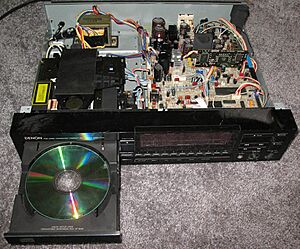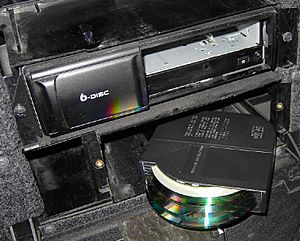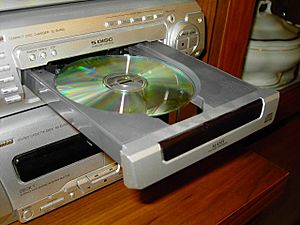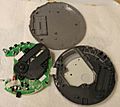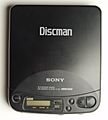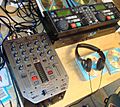Compact disc player facts for kids
A Compact Disc player, or CD player, is an electronic device. It plays music from Compact Discs. You can find CD players in many places. They are often part of home stereo systems. They are also in car audio systems and personal computers. Some CD players are small and portable, so you can take them anywhere.
Today, many CD players can play more than just regular CDs. They can play DVDs, CD-ROMs with music files, and even video CDs. DJs sometimes use special CD players. These players let them change the speed of the music. This changes the pitch (how high or low the sound is). Many newer CD players can also play MP3 CDs. You can also play CDs on computers with CD-ROM/DVD-ROM drives. Even DVD players and some game consoles can play CDs.
Contents
What a CD Player Looks Like
Most CD players come in a case made of plastic and metal. This case holds all the electronic parts inside. It also has the buttons and screen you use to control it.
Portable CD players have special ports. These ports let you connect the player to speakers, headphones, or a power source. Portable players usually run on batteries.
Larger CD players for home use might have speakers built in. Some even include a radio or a tape deck. CD players that are part of a bigger audio system have many ports. These ports connect the player to other parts of your sound system.
How CDs Go In: Tray Designs
CD players have different ways to load the disc.
Tray Loading
Sony released the first CD player, the CDP-101, in 1982. It had a tray that slid out to hold the CD. This design was easy to use and make. Because of this, most CD players since then have used a similar sliding tray.
Top Loading
In 1983, Philips showed off their CD100 player. This was one of the first top-loading CD players. With this design, you lift a lid on top of the player. Then you place the CD inside. A clamp on the lid holds the CD in place when you close it. This design was thought to offer better sound quality. This is because it didn't have motors moving a tray, which could cause tiny vibrations.
How a CD Player Works
A CD player has three main parts:
- A drive motor
- A lens system
- A tracking mechanism
The drive motor spins the CD very fast. It spins between 200 and 500 times per minute. The tracking mechanism moves the lens system across the CD. The CD has tiny spiral tracks where information is stored. The lens reads this information using a laser beam. This beam usually comes from a laser diode.
The laser reads information by shining a beam onto the CD. The beam reflects back to a sensor. The sensor detects tiny changes in the reflected beam. It uses these changes to read the data. This data is then turned into sound by a special chip called a digital-to-analog converter (DAC).
CDs also have hidden information called a subcode. This tells the player how many songs are on the CD. It also tells the total playing time and the time for each song. This information helps the player speed up or slow down the disc. This makes sure the data is read at a steady speed.
Buttons and Screen
Most CD players have similar controls. They usually have a few buttons and a small screen. Common buttons include:
- Play
- Pause
- Stop
- Skip forward/Fast forward
- Skip back/Rewind
If you have a CD player that holds many CDs, there might be buttons to choose which disc to play. The screen often shows the song number, how much time has passed, or the disc number. Some players can even show CD-Text, which is the song title or artist name.
CD Changers
A CD changer is a device that can hold many Compact Discs at once. It lets you choose and play any of them, one at a time. CD changers are common in home cinema systems and cars. They were also sometimes used with computers.
Types of CD Changers
External Cartridge
Some CD changers use an external cartridge. You load up to 12 CDs into this cartridge. Then you insert the cartridge into the CD changer. The changer can then pick one CD at a time to play. These are often found in cars. They make it easy to switch between many CDs.
Internal Cartridge
Internal cartridge CD changers work similarly. But the cartridge stays inside the player. You put multiple CDs into a single slot. The player then stores them inside.
Carousel
A carousel CD changer has a round tray that holds three or more CDs. You pull out the tray, place the CDs, and push it back in. The changer can then spin the carousel to play any of the CDs. You can often change CDs on the carousel while one is playing, as long as you don't disturb the playing disc.
There are also "jukebox" style CD changers. These can hold anywhere from 50 to 300 discs! They store discs vertically in slots around a large carousel. When you pick a song, the carousel spins. A special arm picks up the disc and puts it into the player. These changers often let you type in the names of your CDs. Some can even get the titles automatically if the CD has CD-Text information.
The Future of Music Players
Today, digital audio players like the iPod have largely replaced CD changers. A small digital player can hold thousands of songs. This is like having hundreds of CDs in your pocket! These players are much smaller than any CD changer. While some digital players use compressed music files, many can also play high-quality files. These files sound just as good as a CD.
Computers also used to have CD-ROM changers. These were expensive external drives in the early 1990s. They let computers access many CDs. But now, hard drives can store huge amounts of data. So, one hard drive can hold the information from many CDs. This has made CD-ROM changers less common.
Images for kids
-
A JVC FS-SD5R CD player from the 1990s with a transparent plastic cover and blue backlight
-
Philips Portable CD player disassembled
-
An early portable player, a Sony Discman model D-121
See also
 In Spanish: Reproductor de CD para niños
In Spanish: Reproductor de CD para niños



